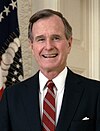Housing and Community Development Act of 1992
Housing and Community Development Act of 1992 was first introduced to the 102nd Congress on June 5, 1992, and was signed and made law by President
History
On June 5, 1992, the Housing and Community Development Act of 1992 was introduced to the
Overview
The Housing and Community Development Act of 1992 amended and extended a number of laws related to housing assistance, home ownership,
It also amends the Cranston-Gonzalez National Affordable Housing Act of 1990 to set aside money for the Home-ownership and Opportunity for People Everywhere (HOPE) programs, the pet project of Jack Kemp, then Secretary of Housing and Urban Development. It directs the Secretary to reduce the fund matching requirement for HOPE I (Public and Indian housing) home-ownership programs.[3] It allows for mutual housing associations to apply for HOPE II grants (for home-ownership of multifamily units). Lastly, it gives families residing in public or Indian housing the ability to move to vacant units under the HOPE III program (home-ownership of single-family homes).[2]
The purpose was to establish funding and a system of checks and balances over government-sponsored entities that work on housing needs.[1]
Title XV of this act is known as the Annunzio-Wylie Anti-Money Laundering Act, which adds penalties for banks found guilty of money laundering - such as revoking their FDIC insurance. It also created the requirement for Suspicious Activity Reports, and formed the Bank Secrecy Act Advisory Group.[1][4][5][6]
See also
References
- ^ a b c d "Wiki - Housing and Community Development Act of 1992". www.csbs.org. Retrieved 2017-05-31.
- ^ a b c 102nd Congress (1992). H.R. 5334. Congress.
{{cite book}}: CS1 maint: numeric names: authors list (link) - ^ a b c Congress, 102nd. "H.R. 5334 Housing and Community Development Act of 1992". Congress.gov.
{{cite web}}: CS1 maint: numeric names: authors list (link) - ^ "History of Anti-Money Laundering Legislation". FDIC. Retrieved August 5, 2020.
- ^ "History of Anti-Money Laundering Laws". FINCEN. Retrieved August 5, 2020.
- ^ "Testimony of Stuart Eizenstat to the Hearing on the Administration's National Money Laundering Strategy for 2001". Federation of American Scientists. Retrieved August 5, 2020.


